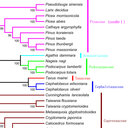Novel dimeric bis(7)-tacrine proton-dependently inhibits NMDA-activated currents.
Słowa kluczowe
Abstrakcyjny
Bis(7)-tacrine has been shown to prevent glutamate-induced neuronal apoptosis by blocking NMDA receptors. However, the characteristics of the inhibition have not been fully elucidated. In this study, we further characterize the features of bis(7)-tacrine inhibition of NMDA-activated current in cultured rat hippocampal neurons. The results show that with the increase of extracellular pH, the inhibitory effect decreases dramatically. At pH 8.0, the concentration-response curve of bis(7)-tacrine is shifted rightwards with the IC(50) value increased from 0.19+/-0.03 microM to 0.41+/-0.04 microM. In addition, bis(7)-tacrine shifts the proton inhibition curve rightwards. Furthermore, the inhibitory effect of bis(7)-tacrine is not altered by the presence of the NMDA receptor proton sensor shield spermidine. These results indicate that bis(7)-tacrine inhibits NMDA-activated current in a pH-dependent manner by sensitizing NMDA receptors to proton inhibition, rendering it potentially beneficial therapeutic effects under acidic conditions associated with stroke and ischemia.



